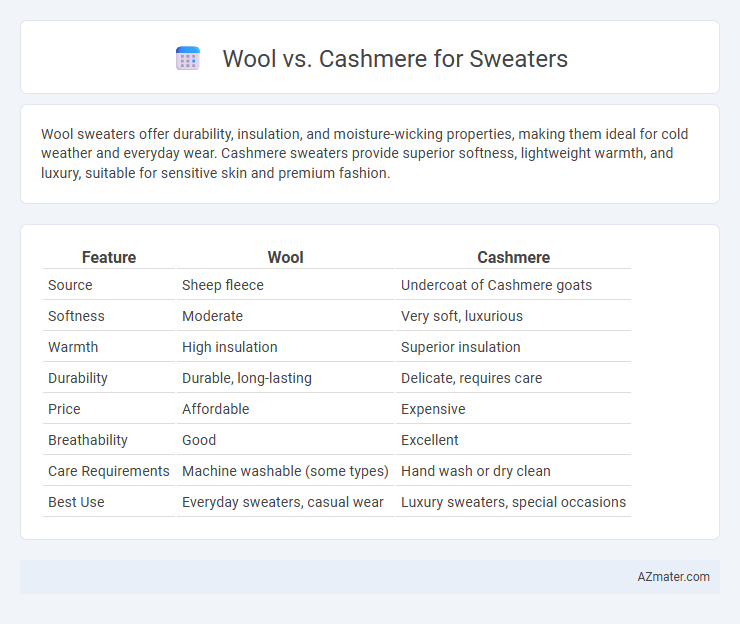Wool sweaters offer durability, insulation, and moisture-wicking properties, making them ideal for cold weather and everyday wear. Cashmere sweaters provide superior softness, lightweight warmth, and luxury, suitable for sensitive skin and premium fashion.
Table of Comparison
| Feature | Wool | Cashmere |
|---|---|---|
| Source | Sheep fleece | Undercoat of Cashmere goats |
| Softness | Moderate | Very soft, luxurious |
| Warmth | High insulation | Superior insulation |
| Durability | Durable, long-lasting | Delicate, requires care |
| Price | Affordable | Expensive |
| Breathability | Good | Excellent |
| Care Requirements | Machine washable (some types) | Hand wash or dry clean |
| Best Use | Everyday sweaters, casual wear | Luxury sweaters, special occasions |
Introduction to Wool and Cashmere Sweaters
Wool sweaters, made from the fleece of sheep, offer excellent warmth, durability, and moisture-wicking properties, making them ideal for cold weather. Cashmere sweaters, crafted from the soft undercoat of cashmere goats, provide exceptional softness, lightweight insulation, and luxurious comfort. Both fibers present unique qualities, with wool prioritizing robustness and cashmere emphasizing smooth texture and refined warmth.
Origins and Production Process
Wool originates primarily from sheep breeds such as Merino, known for their fine, durable fibers, whereas cashmere is sourced from the undercoat of cashmere goats found mainly in Mongolia, China, and Nepal. The production process for wool involves shearing, washing, carding, and spinning, maintaining a thicker, coarser texture ideal for heat retention. Cashmere fibers undergo a delicate dehairing process to separate the fine undercoat from coarse guard hairs, resulting in a softer, lighter, and more luxurious material prized for its exceptional insulation and smooth feel.
Texture and Feel: Wool vs Cashmere
Cashmere offers a notably softer, smoother texture compared to wool, making it highly sought after for luxurious sweaters. Wool fibers are coarser and more durable, providing greater warmth and resilience but with a slightly rougher feel against the skin. The fine, lightweight nature of cashmere results in a silky, breathable fabric, while wool's denser texture delivers robust insulation for colder climates.
Warmth and Insulation Comparison
Cashmere offers superior warmth and insulation compared to regular wool due to its finer fibers, which trap more heat while remaining lightweight. Wool provides excellent insulation as well, with natural moisture-wicking properties that help regulate body temperature in varying climates. Both materials maintain heat efficiently, but cashmere excels in softness and thermal insulation, making it ideal for colder conditions.
Durability and Longevity
Wool sweaters boast exceptional durability due to the natural resilience of wool fibers, which resist wear and maintain shape over time, making them ideal for everyday use. Cashmere, while luxuriously soft and warm, is more delicate and prone to pilling and fiber breakage, requiring careful handling to preserve longevity. Investing in wool sweaters typically results in longer-lasting garments, but high-quality cashmere can also endure with proper care and minimal friction.
Care and Maintenance Tips
Wool sweaters require gentle hand washing in cold water or dry cleaning to maintain fiber integrity, while cashmere demands even more delicate care, including hand washing with specialized cashmere detergent and flat drying to prevent stretching. Avoiding heat exposure and frequent wearing extends the lifespan of both materials, with cashmere especially prone to pilling that can be managed using fabric shavers. Proper storage in breathable garment bags and regular airing helps preserve the softness and shape of wool and cashmere sweaters.
Price Differences and Value
Cashmere sweaters typically command higher prices than wool due to their luxurious softness and rarity, with cashmere often costing two to three times more per garment. Wool offers better durability and warmth at a more affordable price point, making it a practical choice for everyday wear. Investing in cashmere provides superior comfort and elegance, but wool delivers greater value for consumers prioritizing budget and longevity.
Environmental Impact and Sustainability
Wool is a renewable fiber sourced from sheep that biodegrades naturally, but its environmental impact varies based on farming practices, including land use and methane emissions. Cashmere, harvested from goats, offers a softer texture but demands more resources and large grazing areas, often leading to overgrazing and desertification. Sustainable sweater production prioritizes responsibly sourced wool and cashmere certified by organizations like the Sustainable Fibre Alliance to reduce ecological footprints.
Style and Versatility in Fashion
Wool offers a robust, classic texture that complements both casual and formal sweater styles, providing warmth and durability ideal for everyday wear. Cashmere delivers a luxurious softness and elegant drape, enhancing sophisticated looks with lightweight comfort suitable for layering in diverse settings. Both fibers excel in versatility, with wool lending structure to rugged, timeless fashion and cashmere elevating minimalist, high-end ensembles.
Choosing the Best Material for Your Needs
Wool offers excellent insulation and durability, making it ideal for cold-weather sweaters that require long-lasting warmth and resilience. Cashmere provides superior softness and lightweight comfort, perfect for those seeking luxury and gentle warmth without bulk. When choosing between wool and cashmere, prioritize factors like budget, sensitivity to itchiness, and desired fabric weight to select the best material for your comfort and lifestyle needs.

Infographic: Wool vs Cashmere for Sweater
 azmater.com
azmater.com